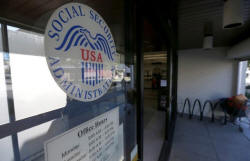U.S. Social Security funding should ease
customer-service crisis
 Send a link to a friend
Send a link to a friend
 [March 28, 2018]
(The opinions expressed here are those of the author, a
columnist for Reuters) [March 28, 2018]
(The opinions expressed here are those of the author, a
columnist for Reuters)
By Mark Miller
CHICAGO (Reuters) - Need help from the
Social Security Administration with your benefits? Be prepared for a
long wait.
Years of budget cuts by Congress have left the Social Security
Administration (SSA) short of staff on its toll-free customer service
line. Long lines form daily outside many local field offices. And the
backlog of people waiting for a hearing on disability insurance claims
is more than 600 days.
But last week, Congress made a downpayment on a badly needed fix for the
customer-service crisis plaguing the agency. Lawmakers ignored the Trump
administration's request to hold the SSA budget flat, instead boosting
the agency’s administrative budget by $480 million as part of the $1.3
trillion omnibus spending legislation signed into law by the president.

Few government agencies touch as many lives as the Social Security
Administration. In fiscal 2017, the agency paid $990 billion in benefits
to 67 million retired or disabled workers, survivors and recipients of
Supplemental Security Income. The agency interacts with the public
through its network of more than 1,200 field offices, its website and
its toll-free teleservice.
Demand for SSA services is rising as the nation ages, with about 1
million new claimants coming on board each year. But budget cuts have
forced sharp reductions in staffing and other resources that have
damaged the agency’s ability to provide effective, timely public
service.
The most serious problem is a historic backlog in appeals by people
trying to claim disability benefits. According to agency data, the
average wait for a response on an initial SSDI application or
“reconsideration” (a form of quick appeal available in 40 states) was
212 days in fiscal 2017, and the average wait for an appeal decision was
605 days. More than 1.1 million people are waiting for a hearing
decision.
But the service crisis affects people attempting to transact all manner
of business with the SSA. The average waiting time to see a claims agent
in the field offices has been rising; waiting times to get help on the
SSA’s toll-free number have also ballooned - the average wait is 30
minutes, and callers are on hold for as long as two hours at peak times.
Slow processing of paperwork can keep beneficiaries in limbo for months
and even years waiting for mistakes to be corrected.
An SSA spokesman declined to comment for this column, saying only that
the agency is reviewing the new legislation.
BUDGET SHRINKS AS ENROLLMENT RISES
The agency’s operating budget has been cut 11 percent from 2010 to 2017
in inflation-adjusted terms; at the same time, the number of
beneficiaries rose 13 percent.
[to top of second column] |

The entrance and logo of a Social Security Office in Pasadena,
California U.S., March 14, 2017. REUTERS/Mario Anzuoni

The cuts have forced a reduction of 3,200 field office staffers since 2010,
according to data from the National Council of Social Security Management
Associations (NCSSMA), a membership organization composed of SSA field office
and teleservice center managers. The staff losses often have come through
attrition as older, more experienced staff depart. More than 60 field offices
have closed, and office hours have been reduced.
Against that backdrop, the budget allocation for fiscal 2018 is just a small
start in the right direction. The omnibus legislation increases the SSA budget
by $480 million over FY 17’s appropriation; $280 million of that is earmarked
for badly needed information technology upgrades. Another $100 million is tagged
for reducing the disability backlog. Another $100 million is general funding
that can be used to improve field office and toll-free teleservice operations.
Advocacy groups welcomed the funding news last week. But they noted that the
hole that the SSA needs to climb out of is deep. If the agency’s budget had only
kept pace with the Consumer Price Index since fiscal 2010, it would be more than
$1 billion higher next year than the $12.1 billion that has just been allocated,
said Kathleen Romig, senior policy analyst at the Center on Budget and Policy
Priorities, who tracks the operations of the SSA.
That is a conservative figure, she notes, because the SSA’s costs for big items
such as office rent and healthcare tend to rise more quickly than the CPI. “And
all of that is figured in before you consider that the number of beneficiaries
served is growing by 1 million a year,” she said.
Even the increased funding for disability hearings will not turn things around
overnight. Much will depend on how the money is spent, said Lisa Ekman, director
of government affairs for the National Organization of Social Security
Claimants’ Representatives, a group of attorneys that handles disability cases.
“While $100 million sounds like a lot of money, it’s a drop in the bucket in the
context of the chronic underfunding of the system that has been going on for
years.”

The key question, said Romig, is whether the SSA receives higher funding on a
consistent basis in the years ahead. “We didn’t expect Congress to reverse all
the damage in a single year, but we will need them to continue to increase SSA’s
funding if we want them to meaningfully address the agency’s problems.”
(Editing by Matthew Lewis)
[© 2018 Thomson Reuters. All rights
reserved.] Copyright 2018 Reuters. All rights reserved. This material may not be published,
broadcast, rewritten or redistributed.
Thompson Reuters is solely responsible for this content. |